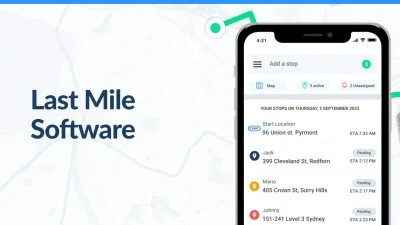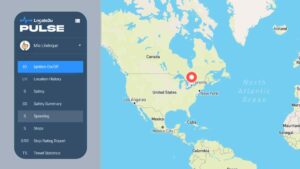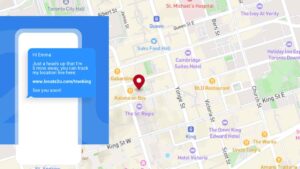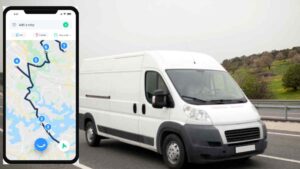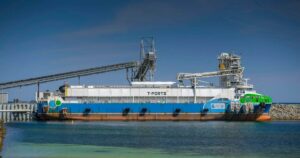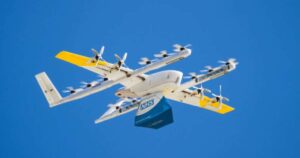The benefits of route optimization for last-mile delivery are key in allowing businesses to maintain a competitive advantage and ensure their drivers are on the most efficient route possible.
Logistics businesses utilize route optimization to design the most affordable and efficient delivery routes. This article will examine the advantages of route optimization for last-mile delivery and how it may assist companies in meeting contemporary market expectations.
What is last-mile delivery?
The last stage of the delivery process, known as the “last mile,” involves moving items from a transportation hub or distribution center to their final location, usually a customer’s house or place of business.
This step of the delivery process is frequently the most difficult and expensive as it entails negotiating crowded urban areas, resolving traffic and parking challenges, and guaranteeing that goods are delivered in a timely manner.
The following steps are frequently included in the last-mile delivery process:
- From the warehouse or distribution facility to a transportation hub or nearby depot, goods are delivered.
- The locations of the clients, the orders that have been received, and the vehicles that are available are used to plan the delivery routes.
- The required goods are put onto delivery vans before they are sent out to make the deliveries.
- Deliveries are provided to the clients, and any necessary signatures or other paperwork is collected.
- Upon at the transportation hub or nearby depot, delivery vehicles unload any leftover cargo.

Last-mile delivery challenges include:
- Demand for same-day or next-day delivery has increased
- Congestion in urban areas and urbanization
- Finding parking and traveling through small streets are challenges
- High delivery expenses, including those for fuel, labor, and vehicle upkeep
- Ensuring timely delivery of the appropriate commodity to the appropriate consumer
These difficulties can have a big impact on route planning and make it hard to establish delivery routes that are as effective and cost-effective as possible.
Businesses can overcome these obstacles and enhance their last-mile logistics with the appropriate tools and approaches.
The benefits of route optimization for last-mile delivery
The benefits of route optimization for last-mile delivery include reduced costs, increased efficiency, improved customer service, and better flexibility and control.
Reduced costs
The number of vehicles required for delivery as well as the cost of labor and fuel can be decreased with route optimization.
Companies can cut the time and resources needed for last-mile delivery by determining the most efficient and economical routes, which will eventually increase profitability.
Increased efficiency
Route optimization software can determine the most effective delivery routes, cutting down on travel time and increasing delivery speed, by utilizing sophisticated algorithms and data analysis.
This can assist businesses in expanding their delivery capabilities, streamlining their processes, and enhancing overall logistics effectiveness.
Improved customer service
With streamlined routes, customers can receive their deliveries more quickly and consistently. This might lead to greater customer loyalty and repeat business.
Businesses can benefit from route optimization by avoiding common delivery issues like missing or delayed goods, which can damage their brand and reduce customer confidence.
Better flexibility and control
Many route optimization software tools provide real-time tracking and delivery updates, enabling users to change delivery dates and places as necessary.
By doing this, it will be less likely that last-mile deliveries will be missed and customers will get their products when and where it’s convenient for them.
Strategies for Route Optimization in Last-Mile Delivery
Time is of the essence in the last-mile delivery industry. Companies and customers alike anticipate quick and effective deliveries, which logistics companies may find difficult to deliver.
But, with the appropriate route optimization techniques, it is possible to strike a balance between delivery distance, speed, and fuel efficiency, all while maintaining client satisfaction.
Optimization Strategies:
Dynamic Routing
This tactic involves adjusting delivery routes in real time based on weather, traffic, and other variables that may affect delivery delays. Logistics organizations may guarantee that their drivers always take the quickest and most effective routes to their destinations by regularly updating their routes.
Multi-Stop Routing
Rather than making separate journeys for each delivery, with multi-stop routing, drivers make several deliveries in a single trip. By route optimization, drivers can make the most use of their time and fuel, which can save time and save fuel expenses.
Zone-Based Routing
Drivers are assigned to particular zones after delivery locations are divided into zones. As opposed to crisscrossing the delivery area, drivers are now simply driving within a designated zone, which can assist cut down on travel time and fuel expenses.
Best Practices for Incorporating Real-Time Data and Analytics:
- Using GPS tracking: Enables logistics businesses to monitor their drivers in real time and modify routes as necessary. By doing so, you can make sure that drivers follow the most effective routes and that deliveries are done on schedule.
- Integrate Traffic Data: Travel times can be predicted using traffic data, and routes can be modified accordingly. Logistics companies can assist drivers in avoiding traffic jams and shortening delivery times by incorporating real-time traffic data into route planning.
- Evaluate Past Data: Logistics businesses can find patterns and trends that can be used to improve future routes by looking at past delivery data. For instance, logistics organizations can modify routes to minimize congestion if specific places often have higher traffic at particular times of the day.
Balancing Delivery Speed, Distance, and Fuel Efficiency
Use Efficient Vehicles: The correct last-mile delivery vehicles can significantly improve fuel efficiency. Short-distance deliveries can benefit from using electric or hybrid vehicles because they use less fuel than conventional gas-powered vehicles.
Improve Delivery Schedules: Logistics companies can cut down on travel time and fuel expenses by improving delivery timetables. Organizing deliveries by zip code or delivery window, for instance, can assist drivers travel less distance.
Reduce Idle Time: Idle time might result in fuel waste and longer delivery delays. Drivers can lower fuel usage and complete deliveries more quickly by cutting down on idle time.
Tools and Technologies for Last-Mile Route Optimization
Geographic Information Systems (GIS)
Businesses can use GIS, a mapping program, to visualize and analyze their delivery routes based on a variety of variables, including traffic, weather, and road conditions.
GIS can assist businesses in determining the most effective routes depending on the locations of their customers and their delivery schedules.
Route Optimization Software
Using algorithms, route optimization software determines the most effective routes depending on a variety of variables, including delivery windows, truck capacity, and traffic conditions. In response to shifting conditions, this software can also optimize routes in real time.
Telematics and Fleet Management Software
Businesses can watch their delivery cars in real-time, keep tabs on driver conduct, and improve routes using real-time data with the use of telematics and fleet management software.
By recognizing inefficient driving habits, this software can also assist businesses in decreasing fuel expenditures and improving vehicle maintenance.
When choosing a tool or technology for last-mile route optimization, it’s essential to consider the following factors:
- Integration
- Scalability
- User-friendliness
- Cost-effectiveness
In summary, a variety of technologies and solutions are available for optimizing last-mile routes; organizations should select the one that best satisfies their needs and specifications.
Businesses may optimize their last-mile delivery routes, increase productivity, and cut costs by utilizing these tools and technology.
Implementation and Integration of Route Optimization
Although integrating route optimization into your last-mile delivery operations can be difficult, it is crucial for companies that want to increase productivity, cut costs, and enhance customer experience by building the most efficient route. When performing route optimization, take into account the following steps:
Identify the important stakeholders.
Choose the important participants in the implementation process, such as IT employees, logistics managers, and delivery personnel.
Review your present procedures
Identify areas where route optimization might be used to increase efficiency and lower costs by evaluating your present delivery operations.
Choose the appropriate software and tools.
Choose the tools and software that will work best with your current systems and satisfy your business needs.
Educate your staff
To ensure a smooth transition, instruct your personnel on how to use the new tools and procedures and offer continuing assistance.
Implement and evaluate
Apply the new procedures and tools, then test them to make sure they are up to par with your company’s objectives.
Observe and assess
To boost performance, keep an eye on the new tools and procedures’ efficacy and make necessary adjustments.
Best Practices for Training Staff on New Tools and Processes
Provide thorough instruction
Provide thorough instruction on how to utilize the new tools and procedures, including everything from how to use the software to how to plan routes and track delivery.
Provide constant assistance
To assist personnel in acclimating to the new tools and procedures, and provide continuing support and resources.
Encouraging feedback
Encourage staff feedback on how well the new tools and procedures are working, and use this feedback to make changes.

Colorex eliminates manual planning with route optimization
Colorex, a top supplier of specialized supplies for construction, plastering, and painting trades, faced challenges in providing timely delivery to its customers due to a lack of real-time information and manual route planning.
Route optimization eliminated manual route planning and placed drivers on the most efficient routes, reducing fuel consumption, distance traveled, and delivery time.
“Our drivers are saving a lot of time previously spent planning their routes. The route optimization feature automatically suggests an efficient route based on the deliveries that are loaded for the run. It’s also very flexible, allowing us to adjust it to suit order priorities.” – Marketing & IT Manager, Hayden Whiteman.

Optimize your last-mile operations with Locate2u
The benefits of route optimization for last-mile delivery are crucial for businesses wanting to keep their competitive edge and ensure customer needs are being met.
Locate2u helps businesses streamline their entire supply chain by designing the most efficient last-mile delivery route for drivers. This helps reduce costs, meet same-day delivery expectations and customer satisfaction, promoting repeat business.

